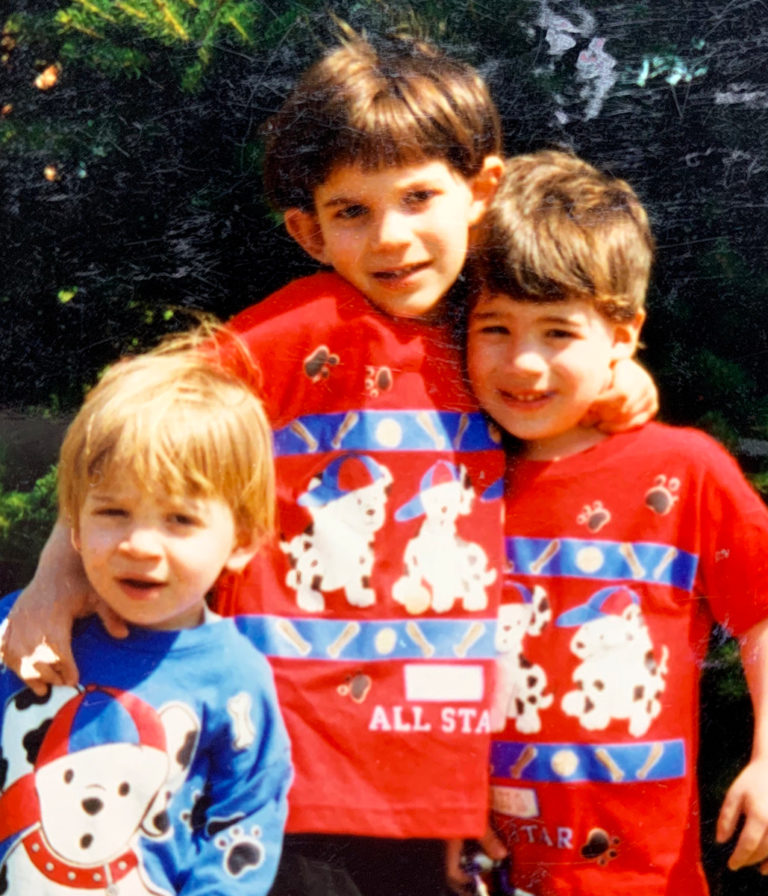Attention Deficit Disorder: “Brian”
“Saying that you can cure dyslexia is like saying that you can cure blue eyes. You either have it or you don’t,” said a recent college graduate with a degree in learning disabilities. My son Brian is living proof that, through God’s grace and the help of NACD, this is not true.
As a preschooler, Brian was a happy, busy, normal little boy. The third of four boys, he was extremely creative, very energetic, and a lot of fun. He loved to wear costumes all day every day. He and his friends chose to entertain themselves with their imagination instead of toys. They loved to put on shows with costumes and props. They transformed our playroom into the dog pound, McDonald’s, a castle, or an island with sharks all around it. Brian’s development was normal. As a young child, he crawled, crept, walked, and talked at a normal time.
When Brian was 5 years old, we decided to home school our children. The activities I did with him were almost all oral and kinesthetic to match his development and interest. He had absolutely no interest in even trying to learn letters, which I dismissed as his temperament. He wanted to be busy, not sitting still looking at letters.
Because he was born August 31, in a school district with a September 1 cutoff day for beginning school, we decided to wait until Brian was 6 to start kindergarten. That way, when he did enter a traditional school, he would not be the youngest in his class. He loved math because it was all oral and he got to play with the manipulatives. No matter how many different ways I tried to teach him his letters, though, he simply could not remember them. We played games with letters, drew letters with chalk on the sidewalk, traced letters with pudding finger paint, sang songs about letters, and anything else we could think of to help him learn. Even after all these activities, he still struggled to recall even a few letters. We both were increasingly frustrated. I knew that either he was not very smart (although he showed certain areas that seemed very bright) or something weird was going on. We decided to have some testing done on him.
In January 1991, when Brian was almost 6 1/2, we took him to the Minirth-Meier Clinic for a psychoeducational evaluation (I.Q. test, etc.). He was given the Wechsler Intelligence Scale for Children, the Beery Test for Visual-Motor Integration, and the Wide Range Achievement Test, Level 1. On his I.Q. test, his verbal score was 119, and his performance score was 82. In a normal child, the I.Q. will be within five points on the two parts of the test. If the scores are 16 or more points apart, the child is labeled learning disabled. Brian’s scores were 37 points apart, which was a huge difference. The Beery Test showed an Age Equivalence Score of 5 years, 6 months (10 months behind his actual age). This was considered a severe difficulty in the areas of visual-motor integration and processing. According to the evaluator, “Brian was not able to write the alphabet in sequence and duplicated many letters, left out letters, and wrote letters backwards. He was able to write his numbers from 1 through 20, although the writing was from right to left. All numbers were written backwards except 4, 5, and 6. Brian was also unable to name the months of the year or to count backwards.”
On the Wide Range Achievement Test, Brian ranked at a preschool level in reading and spelling, and a 1st grade level in math. The comment was, “Brian was not able to actually spell any words, but he was able to duplicate some designs. He was also able to write his name. Brian was unable to read any words. He was able to do some arithmetic in his head, although when given paper and pencil, he was unable to write it down accurately. Brian has severe difficulties with written expression, both with letters and with numbers and will need special interventions in order for him to begin learning at his potential.”
The bottom line was that Brian had a severe learning disability and motor problems. They also felt that he had ADD or ADHD and gave me a brochure on the subject with the suggestion that I talk to my pediatrician about medication. I chose not to put Brian on Ritalin because he was already on numerous medications for his severe asthma.
Even at age 6, Brian was struggling with a sense of failure. The evaluator commented that throughout the testing, Brian kept saying, “My little brother can do this, but I can’t do this.” We had never put our children in a position where they were compared, but Brian knew intuitively that there were things he ought to be able to do that he couldn’t do. He felt stupid. His self-esteem was already suffering.
It was suggested that we apply to have Brian tested at the Learning Disabilities Laboratory at the Scottish Rite Hospital, and in February, we were thrilled to hear that we were accepted for an appointment in July. It seemed so far away, but I thought they would really help us.
The results of the testing at Minirth-Meier were very discouraging. The diagnosis helped explain some of the problems we were having, but did not offer very much hope for the future. I started reading everything I could get my hands on. One of the articles I found was in Teaching Home Magazine, (June/July, 1990), a magazine designed for home schoolers. This article stated that there were two camps when it came to learning disabilities: cope and cure. By far, the majority opinion was that the best you could do for your child was to help him cope with his lifelong disability. There was a program, though, that aimed at “curing” the child. That got my attention immediately. The only choice in the “cure” camp was NACD, and I started tracking them down. I ordered a set of tapes from NACD and found them intriguing. I approached NACD as a skeptic. I did not believe that Brian’s learning disability could be cured, but I thought this program might help, and nothing else I was doing was working.
We took Brian to be evaluated by Bob Doman in April 1991, when Brian was 6 1/2 years old. Bob does not like labels, but he agreed that Brian’s brain was very disorganized. What he offered us was hope. Brian’s digit spans were 4 and 4, which means he was processing and storing information in short term memory like a 4 year old. He was right-eyed, right-eared, right-footed, but his hand was mixed dominant. He wrote and colored exclusively with his left hand, but he ate with either hand, threw a ball with his right hand, and seemed to use both hands equally for most tasks. His “handwriting” at this point was almost impossible to read. Bob chose to switch his dominance to the right, which meant changing him from “ambidextrous” to right-handed. In order to change the dominance of his hand, we did many exercises and activities to strengthen his right hand and ignore his left hand. Because most of these activities were fun and certainly better than “school,” Brian gave us very little resistance to the program. We also worked on his digit spans, his balance and coordination, his lung capacity, and his academics. The hardest part of the program was the self-discipline to do it every day. Like any therapy, it gets boring and tedious. We found that we had to exert a tremendous amount of discipline on ourselves to do what needed to be done. The only thing that kept us going was the possibility that this could really work for Brian. We had to keep our eyes on the goal.
One idea that we came up with helped Brian tremendously with his self-esteem. When we first understood the idea behind NACD, (that learning disabilities and ADD are a result of neurological disorganization), we shared with Brian that we had just gotten the best news in the world. The reason he was having problems learning letters was that he had a “tricky brain,” and we had found a way to fix “tricky brains.” We invented a character named “Mr. Tricky,” and every time Brian wrote a letter backwards or couldn’t remember a letter, we would say, “Stop it, Mr. Tricky! Leave Brian alone!” Then we would assure Brian that it was only “Mr. Tricky” who was messing up his brain. It was not his fault that he couldn’t remember that letter. It took the guilt off of him and put it on a neutral party (“Mr. Tricky”) that we were in the process of banishing from his life. This helped him also see that there was an attainable goal in the future, which was no more “tricky brain.”
After 3 months, in July 1991, we had Brian re-evaluated by Bob. His digit spans had improved to 5 and 6, and his dominance was showing some improvement. With a few changes in our program, we were set to press on for another 3 months. We saw very little change in Brian, but we still held out hope that it would work. This evaluation came just before our appointment at Scottish Rite.
At the end of July 1991, we had Brian tested at Scottish Rite. The results of this testing were discouraging. They diagnosed Brian with Specific Developmental Dyslexia, ADD (moderate to severe) and a 2-year motor delay. They were most kind, but not hopeful that Brian would be easily able to overcome these problems. They told me to spend the next year (until he was almost 8 years old) trying very hard to teach Brian his alphabet. When he was 8, if he had learned his alphabet, and if he had increased his attention span, then they would put him in their Dyslexia Laboratory Class. They felt that within 2 1/2 years, by the time he was 10, they could probably teach him to read. I told them about NACD, which they had never heard of. The doctor told me that they found in their studies that 95% of all learning disabled children were mixed dominant, but in their opinion, it didn’t mean anything. I asked if anything we were doing on the NACD program would hurt Brian. They answered that it would not hurt him, but it would not help him. Little did they know what was going on inside Brian’s brain!
In October 1991, shortly after Brian’s 7th birthday, and after we had been on the program 6 months, we had a major breakthrough. Within two weeks time Brian went from struggling to remember his alphabet to reading! The phonics curriculum we were using had small, simple readers. It would take us sometimes two or three weeks to get through one reader because we had to take it one letter at a time. One day in October, Brian picked up a new reader and read the whole thing in one sitting! I couldn’t believe it! He soon was devouring books. His attention span also improved. This was especially evident to his grandparents in Atlanta. We had visited them the previous summer, and Brian was a whirlwind of activity. We were in Atlanta again at Christmas time of that year, and within hours everyone was commenting about Brian and how calm he was. What a change they saw in him! He was acting like a normally active boy instead of a hyperactive boy. We were so excited!
Another dramatic shift we observed was in the area of working jigsaw puzzles. The summer that he was almost 7, Brian could not even work a 12-piece puzzle. He could not visually process enough to tell the difference between an edge piece and a centerpiece. He also did not have the attention span to work on it for very long. When he was 7 1/2, I will always remember the day he chose to get a 100-piece puzzle out of the cabinet and work it by himself! He not only could visually process well enough to put the pieces together, but he also had the attention span to stick with it until it was done. We were thrilled!
In January 1992, we saw Bob again. This time, Brian’s digit spans were 7 and 7, and his dominance was 90% on the right. He was reading on a 4th grade level! Remember that only 5 months previously, he had not been able to read at all! His balance had improved tremendously, and his eye convergence was complete. What progress he had made!
We continued on program, but due to many unusual circumstances, we were not able to see Bob again until October. By then, Brian was doing marvelously well. He was reading on a 6th grade level (at the beginning of 2nd grade). Brian had graduated from NACD as a normal child; no, he was well above normal!
Since then, Brian has used the same advanced curriculum in home school as his older brothers. He continues to test 2 to 5 grade levels ahead on every area of the Iowa Test of Basic Skills. When asked what his favorite subject is, he always answers “Reading!” without hesitation.
Now in 4th grade, we call Brian “Mr. Observant” because he never misses a thing. He plays on football and basketball teams, loves to ride bikes, rollerblade, and everything else a 10-year old boy ought to do. He is a natural leader, extremely reliable, very focused, and will be a huge asset to this world. It is hard to believe that at 10 1/2, he is such a different person than we were led to believe he would be. Gone is the dyslexia, gone is the ADD, gone is the motor delay. Here to stay is a high achieving, focused sports fanatic. We are so thrilled to have found NACD and experience the joy of normalcy! Thank you Lord, and thank you Bob Doman!
UPDATE, April, 2003
Brian is now 18 and graduating from high school next month. He has continued to excel in all areas and has never again shown any signs of dyslexia or ADD since he was “cured” by his NACD program. He is salutatorian of his high school and has been accepted into the highly competitive Business Honors program at Texas A&M University for next year. He scored 1280 on his SAT’s, and other testing has shown a dramatic increase in his I.Q. Without specifically working on it, his visual digit span has risen to 12, and his auditory digit span is at 8. We just tested him for fun last week and discovered this. We agreed he should work on his auditory digit span to get it to that superior level of 12! He is an Eagle Scout, works part-time, played football at his school, has earned the school’s highest award for character three years in a row, and is one of the finest young men you will ever meet. We are very proud of him and thankful to NACD for removing the stumbling blocks that would have kept him from becoming the man he is today.




